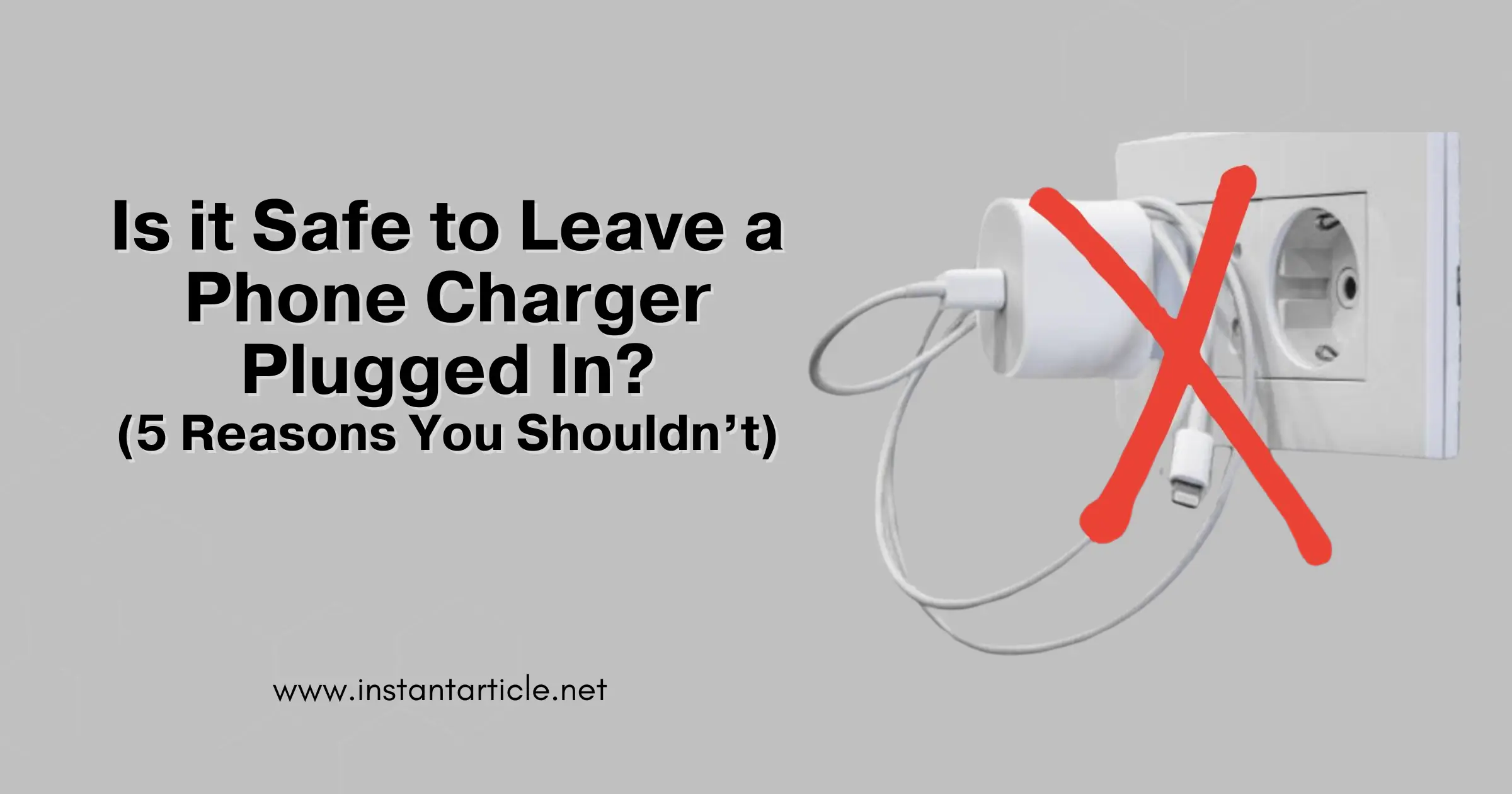Smartphones have become an essential part of our daily lives, constantly keeping us connected, informed, and entertained. But what about the chargers that power these devices? You might have asked yourself, “Is it safe to leave a phone charger plugged in?” Let’s dive into why unplugging your charger when it’s not in use can be a smart move for safety, cost savings, and environmental responsibility.
Understanding Charger Safety
Chargers are vital for keeping our devices powered, yet they often go unnoticed. Understanding how chargers work can help prevent potential issues.
- Basic Components: A typical charger consists of a transformer, a rectifier, and a voltage regulator. These components convert AC electricity into the DC power your phone needs.
- Safety Risks: Defective or improperly used chargers can overheat, short-circuit, or cause electrical malfunctions, leading to fires or damage.
- Manufacturer Guidelines: Follow safety guidelines provided by manufacturers to ensure safe and efficient use.
- Certified Chargers: Use chargers certified by regulatory bodies, as they meet safety standards and minimize risks.
By understanding charger safety, we can make informed decisions about usage and care.
The Risks of Leaving Your Charger Plugged In
Leaving a phone charger plugged in without a connected device may seem harmless, but it can lead to several risks.
Fire Hazards
I remember a time when I left my phone charger plugged in overnight. One afternoon, I smelled something burning and discovered that my charger, which had been left plugged in, was smoking. It was a terrifying reminder of how chargers can overheat if left plugged in for long periods, especially if faulty or damaged. This can significantly increase the risk of electrical fires.
Key Points:
- Overheating can cause chargers to catch fire.
- Damaged chargers are more likely to overheat and spark.
- Unplugging your charger reduces fire hazards.
If you’ve ever experienced something similar, you know the importance of unplugging unused chargers to prevent hazards.
Electrical Surges
Power surges during storms or outages can damage plugged-in electronics. Unplugging your charger protects it and your phone from potential damage. The National Institute of Standards and Technology (NIST) recommends unplugging devices during storms as an effective protection measure.
Key Points:
- Surges can damage plugged-in electronics.
- Unplugging provides protection from unexpected power issues.
- Safety measures prevent potential electrical damage.
Increased Electricity Bills
Leaving chargers plugged in can contribute to higher electricity bills. Chargers consume a small amount of electricity even when not connected to your phone, known as “phantom load” or “vampire power.” According to the Lawrence Berkeley National Laboratory, standby power consumption can account for up to 10% of a home’s electricity use.
Key Points:
- Chargers draw power even when not in use.
- Reducing phantom load can lower energy costs.
- Unplugging saves electricity and money over time.
Think about how much you could save by unplugging devices left plugged in unnecessarily.
Environmental Impact
Our energy habits have a significant effect on the environment. Small changes, like unplugging chargers, can contribute to a more sustainable future.
Carbon Footprint
The energy consumed by idle chargers adds to your carbon footprint. Unplugging your charger is a small but meaningful step toward reducing environmental impact. The United States Environmental Protection Agency (EPA) estimates that reducing idle power usage could save up to 44 million tons of carbon dioxide emissions annually. That’s equivalent to taking about 9 million cars off the road!
Key Points:
- Decreasing energy use reduces carbon emissions.
- Every small action contributes to a healthier planet.
- Being mindful of energy consumption is environmentally responsible.
Imagine the collective impact if everyone took small actions like unplugging chargers.
E-Waste Reduction
Electronic waste, or e-waste, is a growing environmental concern. Chargers that fail due to constant strain from being left plugged in contribute to e-waste.
- Reducing E-Waste: Unplugging chargers extends their lifespan, reducing the number discarded each year.
- Recycling Chargers: Many stores and recycling centers accept old chargers for recycling. Proper disposal prevents harmful chemicals from leaching into the environment.
- Consumer Responsibility: Simple actions to prolong charger life contribute to reducing e-waste.
Reducing e-waste is essential to minimizing the environmental impact of our electronic devices.
Extending Charger Lifespan
Taking care of your charger can save money and reduce waste. Here are some tips to ensure your charger lasts longer.
Wear and Tear
I recall going through several phone chargers in a short period because I left them plugged in constantly. This constant strain leads to wear and tear over time, reducing the charger’s lifespan and necessitating more frequent replacements.
Key Points:
- Unplugging when not in use extends charger life.
- Reducing wear and tear saves money in the long run.
- Proper care ensures your charger lasts longer.
Best Practices for Charger Care
- Unplug When Not in Use: Disconnect your charger when it’s not charging your device.
- Avoid Bending Cords: Keep the cord straight and avoid wrapping it tightly.
- Store Properly: Keep your charger in a dry, safe place away from direct sunlight and moisture.
- Inspect Regularly: Check for signs of wear, such as frayed wires or bent prongs, and replace if necessary.
Following these practices will help extend the life of your charger, saving you money and reducing waste.
Enhancing Safety Measures
Safety should always be a priority when using electronic devices. Here are some ways to enhance safety when using chargers.
Surge Protectors
Investing in surge protectors is a smart way to protect your devices from power surges. These devices absorb excess voltage, preventing damage to your electronics.
- Choosing a Surge Protector: Look for protectors with a high joule rating for better protection.
- Placement: Use surge protectors for all your valuable electronics, especially in areas prone to storms or power fluctuations.
- Regular Replacement: Replace surge protectors every few years, as they can wear out over time.
Regular Inspection of Chargers
Regularly inspecting your chargers can help identify potential problems before they become serious.
- Visual Inspection: Check for physical damage, such as exposed wires or cracks in the casing.
- Testing: Plug the charger into a different outlet to ensure it’s functioning correctly.
- Replacement: Replace any damaged chargers immediately to avoid potential hazards.
By taking these precautions, you can ensure the safety and longevity of your electronic devices.
Cost Implications
Understanding the cost implications of leaving chargers plugged in can motivate us to adopt better habits.
Hidden Costs of Standby Power
Standby power, or vampire power, refers to the energy consumed by devices when they are not in active use but still plugged in.
- Cost of Vampire Power: Although each charger uses a small amount of power, the cumulative effect of all household devices can be significant.
- Energy-Efficient Alternatives: Invest in smart power strips that cut off power to devices not in use, reducing standby power consumption.
- Monitoring Usage: Use energy monitors to track and manage your household’s power consumption.
Long-term Financial Benefits
Taking steps to reduce standby power can lead to long-term financial benefits.
- Lower Electricity Bills: Unplugging devices reduces overall energy consumption, leading to lower bills.
- Increased Device Lifespan: Extending the lifespan of chargers and other devices saves money on replacements.
- Informed Consumer Choices: Being aware of energy consumption helps make better purchasing decisions, such as choosing energy-efficient products.
Understanding these cost implications can motivate us to adopt more energy-efficient habits.
Technological Advancements and Charger Design
Advancements in technology have led to more efficient and safer chargers. Here’s what’s new in charger design.
Smart Chargers
Smart chargers are designed to optimize charging while minimizing energy waste.
- Features: Many smart chargers have automatic shut-off, fast charging, and energy-saving modes.
- Benefits: These features help protect your device’s battery and reduce energy consumption.
- Availability: Smart chargers are becoming more common and are available for various devices.
Energy-Efficient Technologies
New technologies are improving charger efficiency and safety.
- GaN Technology: Gallium Nitride (GaN) chargers are smaller and more efficient than traditional chargers.
- Wireless Charging: Wireless chargers eliminate the need for cords, reducing wear and tear.
- Universal Compatibility: Many new chargers are designed to work with multiple devices, reducing the need for multiple chargers.
These advancements are making chargers safer, more efficient, and more environmentally friendly.
Practical Tips for Managing Chargers
Managing your chargers efficiently can save time, money, and energy. Here are some practical tips.
How to Organize and Store Chargers
Keeping your chargers organized helps prevent damage and makes them easy to find when needed.
- Label Chargers: Label each charger with the device it belongs to.
- Use Cable Ties: Keep cords neat and untangled with cable ties or Velcro straps.
- Designate a Charging Station: Set up a dedicated area for charging devices, complete with a power strip or surge protector.
- Storage Solutions: Use a drawer or organizer to store chargers not in use.
Tips for Travel and On-the-Go Charging
When traveling, managing your chargers effectively can prevent hassles and ensure your devices stay powered.
- Portable Chargers: Invest in a high-quality portable charger for on-the-go power.
- Multi-Device Chargers: Consider chargers that can charge multiple devices simultaneously.
- Travel Pouches: Use a travel pouch to keep all your charging accessories organized.
- Adapters: Carry universal adapters for international travel.
These tips can help you manage your chargers efficiently, both at home and on the go.
Real-life Experiences and Anecdotes
Hearing from others can provide valuable insights and highlight the importance of charger safety.
- Personal Stories: Many people have experienced the consequences of leaving chargers plugged in, from minor electrical shocks to more serious incidents.
- Lessons Learned: These experiences emphasize the importance of unplugging chargers and following safety guidelines.
- Community Sharing: Online forums and social media platforms are great places to share experiences and learn from others.
By sharing our experiences, we can help others avoid potential risks and adopt safer habits.
Conclusion
So, is it safe to leave a phone charger plugged in? The simple answer is no. By unplugging your charger when not in use, you can avoid potential fire hazards, save on electricity bills, reduce your carbon footprint, extend the lifespan of your charger, and protect your devices from electrical surges.
Take a moment now to check your home. How many chargers are currently plugged in without a phone attached? By unplugging these chargers, you contribute to a safer home environment, a healthier planet, and long-term savings. Remember, it’s the little changes that make a big difference.
Frequently Asked Questions (FAQs)
While not always immediately dangerous, leaving a charger plugged in can increase the risk of fire hazards due to overheating or faulty wiring. It is safer to unplug chargers when not in use.
Yes, leaving a charger plugged in consumes a small amount of electricity, known as phantom load or vampire power. Although it may seem negligible, it can add up over time and contribute to higher electricity bills.
To protect your devices from power surges, unplug chargers and electronics during storms or outages. Additionally, consider using surge protectors to safeguard your valuable devices.
Unplugging chargers reduces energy consumption, leading to lower carbon emissions. This small action contributes to a healthier planet by decreasing your overall carbon footprint.
To extend the lifespan of your phone charger, unplug it when not in use to reduce wear and tear. Avoid bending or pulling the cord excessively, and store it in a safe, dry place to prevent damage.
Smart chargers offer features like automatic shut-off and energy-saving modes, making them a worthwhile investment for reducing energy consumption and protecting your device’s battery.

